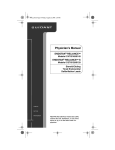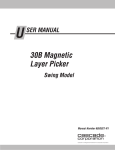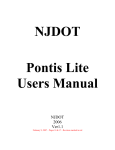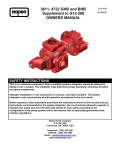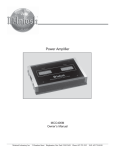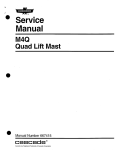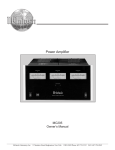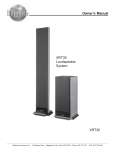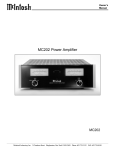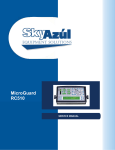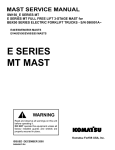Download Free Lift Cylinder Service
Transcript
Service Manual 35D/40D/50D/55D/55ND/60D Full Free Lift 2-Stage Mast - MD Manual Part Number 689225 R5 Lift Technologies, Inc. 2007 Contents INTRODUCTION, Section 1 Introduction Special Definitions Tool Requirements INSTALLATION INSTRUCTIONS, Section 2 Truck System Requirements Mounting Bracket Installation Mast Installation Inspection and Adjustments Chain Inspection and Tension Free Lift Chain Adjustment Upright Rail Lubrication Cylinder Bleeding Mast Skewing Internal Reeving Installation PERIODIC MAINTENANCE, Section 3 TROUBLESHOOTING, Section 4 SERVICE, Section 5 Mast Removal Cylinders Main Lift Cylinder Description Free Lift Cylinder Description Cylinder Operation Main Lift Cylinder Removal- Mast on Floor Free Lift Cylinder Removal- Mast on Floor Free Lift Cylinder Removal- Mast on Truck Main Lift Cylinder Service Free Lift Cylinder Service Piston Removal Cylinder Bleeding Valve Valve Cartridge Service Carriage Description Carriage Removal- Mast on Truck Carriage Removal- Mast on Floor Carriage Inspection Mast Uprights Upright Description Upright Operation Upright Disassembly Upright Inspection Upright Reassembly Mast Skewing Chains Inspection and Tension Measuring Chain Stretch Free Lift Chain Adjustment Free Lift Chain Service 3 Page 4 4 4 4 5 5 5 6 7 7 7 7 8 8 9 10 11 12 12 13 13 14 15 17 18 19 20 21 22 22 22 23 24 24 25 26 27 28 28 29 30 30 31 32 33 33 34 34 35 689225 R5 Section 1.1 1Introduction Introduction This manual Provides the installation Instruction, periodic maintenance, troubleshooting and service procedures for the Lift Tek Series roller masts. In any communication about the mast, refer to the mast serial number stamped in the nameplate. If the nameplate is missing, these numbers are also stamped on the left-hand upper cheekplate. See Figure 1. WARNING: Do not install a Lift Tek Mast on a truck with a capacity greater than the truck rated capacities shown below XXXXXX XXXX OR XXXXXX XXXXXX XXXX Stamped Serial Numbers XXXXXX XXXX MA2779.eps 35D 3500 lbs. (1585 kg) 40D 4000 lbs. (1812 kg) 50D 5000 lbs. (2268 kg) 55D 5500 lbs. (2491kg) 60D 6000 lbs. (2718 kg) Example: 55D–MT–001–00025–M Figure 1. Serial Mast Number Location Modifications and additions which affect capacity or safe operation shall not be performed without prior written approval from Lift Technologies per ANSI B56. 1. 1.2 Special Definitions WARNING WARNING is information A statement preceded by that should be acted upon to prevent bodily injury. A WARNING is always inside a ruled box. CAUTION A statement preceded by CAUTION is information that should be acted upon to prevent machine damage. IMPORTANT A statement preceded by IMPORTANT that possesses special significance. NOTE A statement preceded by NOTE is information that is handy 1.3 Tool Requirements Listed below are the minimum tools needed to work on a. METRIC 17, 19, 24 mm Open End or Socket Wrench INCH 3/4, 13/16, 7/8, 15/16, 1.0, 1-1/16 in Open End or Socket Wrench. 1/8 in. Allen Wrench Snap Ring Pliers Claw Type Spanner Wrench Strap Wrench Torque Wrench 2 lb. Dead Blow Hammer 4 689225 R5 Section 2.1 2 Installation Instructions Truck System Requirements To achieve maximum lifting capacity of the mast, the truck relief valve should be set to relieve at the pressure indicated in the chart below. This chart also indicates the hose fitting size to use between the truck control valve and masts valve. Lift Tek Mast 30D/35D/40D 30D/35D/40D 50D/55D/60D Relief Hose Fitting* Pressure Size Size 2000 psi No. 8 min. No. 8 min. 2600 psi No. 6 min. No. 6 min. 2600 psi No. 8 min. 13/32 in. Orfice * Valve inlet port is 3/4 in. SAE O-ring. See Figure 2. MA0022.eps WARNING: For proper truck stability or to prevent interference, tilt restriction may be required. Contact the truck manufacturer. IMPORTANT: Lift Tek Masts are compatible with SAE 10W petroleum base oil per Mil. Spec. MIL-0-5606 or MIL-0-2104 B only. Use of synthetic or aqueous base hydraulic oil is not recommended. If fire resistant hydraulic oil must be used, contact Lift Tek. 2.2 Mounting Bracket Installation Valve Inlet Port 3/4 in. SAE O-ring FigFigure 2. Valve inlet Port. Truck Cowl A B If it is1necessary to install mounting brackets and crossmembers to fit your lift truck, consult with the nearest Lift Tek Service Department listed on the back cover. You must supply dimensions A through F shown in Figure 3. Failure to install the correct brackets and crossmembers can result in mast structural failure, bodily injury and loss of warranty. C D Front View Tilt Cylinders WARNING: Failure to install the correct brackets and crossmembers can result in mast structural failure, bodily injury and loss of warranty. E F Side View MA0031.eps Figure 3. Determining Mounting Bracket Location. 5 689225 R5 Section 2.3 2 Installation Instructions Mast Installation 1 The following instructions and illustrations are typical for most trucks. If your truck does not match, contact lift-Tek support. 1. Raise and block the front end of the truck 1ft. (30 cm) per ANSI B56.1 or drive the truck over a service pit. 2. Install the bearings to lower the axle mounts. 3. Lubricate the bearing surfaces of the lower axle and tilt cylinder mounting brackets with chassis grease. 4 4. Lift the mast using an overhead hoist with a lifting strap attached under all of the upper crossmembers. Position the mast by lowering the axle mounts on the truck axle. Install the mount caps and capscrews. Tighten the capscrews to the truck manufacturer’s torque specifications. IMPORTANT: Prior to connecting the tilt cylinders to the mast, make sure the cylinders “bottom” evenly. Adjust the tilt cylinders to prevent the mast from “racking” during tilting. Refer to your truck service manual for procedures. 5. Connect the lift truck hose to the mast valve. 6. Connect the tilt cylinders to the mast anchor brackets. Tighten the pin capscrews to the truck manufacturer’s torque specifications. NOTE: Use as few fittings as possible and always use 45o fittings instead of 90o fittings. Keep the hose lengths to a minimum. Avoid sharp bends or pinch points when routing the hose. 6 5 Contact Lift Tek if additional fittings are required. See back cover. 4 MA2141.eps 2 3 FiFigure 6. Mast Installation. 6 689225 R5 Section 2.4 2.4-1 2 Installation Instructions Inspection and Adjustments Chain Inspection and Tension *3 in. Underclearance *5 in. Underclearance The hoist Chains have been factory lubricated using heat and pressure to force the lubricant thoroughly into the chain links. Avoid removal or contamination of this factory applied lubricant. Do not wash, sand blast, etch, steam clean, or paint the chains for internal mast installation. The chains must be adjusted with equal tension to ensure proper load distribution and mast operation. To determine equal tension, extend the unload mast to put the chains under tension. Press the center of a strand of chain with your thumb, then press at the same place on the other chain of the pair. Each chain in a pair should have equal “give”. If they do not have equal tension, preform the hoist chain adjustments described below. 2.4-2 Outer Upright and Carriage Flush Outer Upright Carriage 2 in. Below Outer Upright MA2777.eps NOTE: Underclearance is based on mast production series, actual mast underclearance may vary by truck model. Figure 4. Upright and Carriage Position. Free Lift Chain adjustment The free lift chains should be adjusted so that when the unloaded mast is fully lowered, the carriage is positioned as shown in Figure 7. 1. Locate the threaded chain anchors on the front side of the inner upright crossmember on each side of the cylinder. 2. Adjust one chain to achieve the correct carriage position when fully lowered, as shown in Figure 7 and 9. Free Lift Cylinder Cylinder Strap Free Lift Adjusting Nuts MA0387.ill 3. Adjust the other chain to achieve equal chain tension. Tighten the nuts together to a torque of 50-70 ft.-lbs. (68-95 Nm). Figure 6. Free Lift Chains. Upright Rails 4. Raise and lower several times to confirm the adjustments. 2.4-3 Upright Rail Lubrication Lubricate the full length of each upright rail with chassis lube or Kendall SR-12X as shown in Figure 11. MA0389.ill LUBRICATE ONLY WHERE INDICATED BY THE HEAVY LINE FOR THE FULL LENGTH OF EACH UPRIGHT Figure 8. Channel lubrication. 7 689225 R5 Section 2.4-4 2 Installation Instructions Cylinder Bleeding WARNING: The cylinders must be bled to remove air. Air in the cylinders will compress on the first extension which could rupture the cylinders causing serious bodily injury and property damage. When new or after repair, the cylinders may have air trapped in them that must be removed. To bleed air do the following: 1. Without a load extend the free lift cylinder and continue to extend the main lift cylinders to 90% of full stroke. Retract all cylinders completely. Repeat three times. 2. Extend the cylinders without a load at 50% full engine speed then build full system pressure at the end of the main lift cylinder stroke. Electric trucks-limit the control valve movement to achieve 50% speed. Retract all cylinders. Repeat four times. 3. Cycle the mast with a half load (50% mast rated capacity) through full cylinder extension several times. The cylinders should extend smoothly. Repeat the steps if cylinder extension is not smooth. 2.4-5 Mast Skewing Check for mast skewing as described in Section 5.5-6. 8 689225 R5 Section 2.5 2 Installation Instructions Internal Reeving Installation 1. Install the fittings on the carriage bracket. 2. Install the front hose guide bracket to the back side of the inner upright crossmember. Tighten the capscrews to a torque of 48-52 ft. -lbs (65-70 Nm). 4 Hoses must not contact bottom of chain anchor mount. 3 3. Install the rear hose bracket to the outer upright by inserting the round bar at the end of the bracket into the hole in the upper outer. 9 4. Attach the lower end of the bracket to the inside of the outer upright chain anchor mounting leaving a gap between the top of the bracket and the chain anchor mount. The bracket should be parallel with the upright. Tighten the capscrew to a torque of 48-52 ft. lbs. (65-70 Nm). Rear Hose Guide Bracket 5. Remove the existing capscrew and guard from one side of the cylinder crosshead. Install the hose sheave and guard with the hardware supplied. Tighten the capscrew to a torque of 48-52 ft.lbs. (65-70 Nm). 7 10 6. Install the hoses to the carriage fittings with the white line facing outward. 4 5 2 8 7. Feed the hoses between the crosshead guard and sheave. Raise the carriage just above freelift. Route the hoses under the front hose guide bracket. Install the hose clamp. Pull on the hoses to remove slack. Tighten the capscrew to a torque of 25-30 ft. lbs. (35-40 Nm). Completely lower the carriage. 11 8. Route the hoses to the rear guide bracket. The loop in the hoses should be 4 in. (101 mm) +/_ 1 in. (25mm) below the bottom of the rear bracket. 9. Install the hose clamps at the top of the rear guide bracket. Make sure the loop is the same for both hoses. Tighten the capscrews to a torque of 25-30 ft. lbs. (3540 Nm). Check and adjust hose clearances. 10. Install the bulkhead fittings to the bracket with the securing nuts located on the top side. Install the hose ends to the fittings. 1 6 11. Move the lowering control valve and bracket to the back side of the center crossmember. Tighten the capscrews to a torque of 25-30 ft. lbs. (35-40 Nm). Check and adjust hose clearances. 12. Raise and lower the mast several times to make sure the hoses are tracking correctly in the guide brackets. Use the white line on the hoses to detect twisting. Adjusting the hose ends with a slight amount of twist may improve hose tracking in the guides. MA2146.eps 11 DETAIL A Left Hand Guide Spacer DETAIL C For Double IHR or Left Hand IHR Left Hand IHR Installs the same as Right Hand IHR with an added spacer on the Left Hand Rear Guide on 30D,35D and 40D Masts when only Left Hand IHR is used. 9 689225 R5 Section 3.1 3 Periodic Maintenance Periodic Maintenance For proper operation and an extended service of life, your Lift Tek Mast should be inspected and serviced regularly as part of your normal lift truck maintenance schedule according to the following outlines and ANSI B56.1 procedures. The recommended intervals are for masts operating under normal conditions. If the mast is operating in severe conditions or corrosive atmospheres, the inspections should be performed more frequently. WARNING: Never work on the mast with a load on the forks or attachment, in the raised position without supports or while anyone is near the lift truck control handles per ANSI B56.1 3.1-1 Daily Inspection Perform the following at the beginning of each work shift: 1. Extend the carriage a few inches off the ground and make sure the chains are under equal tension. Refer to Section 5.6-3 and 5.6-4 for chain adjustment. 2. Extend the mast to its fullest height to make sure the mast rails and carriage extend freely without binding. 3. While the mast is extended, inspect the upright rails for proper lubrication. Refer to Section 5.5-5 Step for rail lubrication. 4. Make sure the internal reeving hoses (if equipped) travel evenly in the hose guides. Adjust the hose ends if required. Tighten the fittings making sure they do not twist. 100 Hour Inspection After each 100 hours of lift truck operation, and in addition to the daily inspection: 1. Inspect and lubricate the full length of the chains with SAE 40 wt. oil or Bowman Heavy Load Red Grease. CAUTION: The chains must be coated with a film of lubricant at all times. 500 Hour Inspection After each 500 hours of lift truck operation, and in addition to the Daily and 100 Hour Inspection: 1. Each pair of load rollers on the uprights and carriage should be shimmed so that a total side to side clearance no greater than 1/16 in. (1.5 mm) occurs at the tightest point throughout the travel of the member. Pry between the upright and load roller so that the opposite load roller is tight against the upright. Measure the clearance for the pair of rollers at XXX shown. See Figure 13. 2. Check the chains for wear and stretch. Refer to Section 5.6-1 for complete chain inspection. 10 Figure 13. Load Roller Clearances. 689225 R5 Section 4 Troubleshooting The following table lis is problems that may be encountered on your Lift Tek Mast, the probable causes and recommended corrective action that should be taken to restore the mast to normal operating condition. PROBLEM PROBABLE CAUSE Cylinders don’t lift load or won't move Empty a) Plugged inlet hose b) Insufficient oil. SOLUTION a) Unplug hose or replace. b) Check the truck hydraulic system for correct oil level in tank, defective pump or pump drive, leaks in the lines or disconnect control valve linkage. Repair or replace as necessary. c) Bent or jammed plunger. c) Repair or replace as necessary. WARNING: Extreme care should be used when working on a unit when the carriage (with or without a load) is in the raised position. Loaded a) Plugged piston check valve. a) Unplug check valve or replace. b) Truck relief valve setting low. b) Raise truck relief setting to specified level. c) Over capacity. c) Reduce load to specified capacity. d) Mechanical bind due to bent plunger d) Remove mechanical bind by or bad rollers. replacing/freeing plunger and rollers. WARNING: Extreme care should be used when working on a unit when the carriage (with or without a load) is in the raised position. Cylinders drifta) External leak in pressure line. a) Tighten or replace as necessary. b) Truck valve defective-cycle to full b) Repair or replace truck valve. lift height to verify. c) External leaks at retainer. c) Replace all cylinder seals. d) Piston check valve leaking. d) Replace check valve. Spongy or jerky action- a) Sticky or defective truck relief valve. a) remove and check the truck relief valve. If contaminated oil caused the malfunction, drain and flush the system, change the filter and refill with fresh oil. WARNING: Extreme care should be used when working on a unit when the carriage (with or without a load) is in the raised position. b) Bent or damaged cylinder plunger. b) Disassemble, check and repair cylinder assembly. WARNING: Extreme care should be used when working on a unit when the carriage (with or without a load) is in the raised position. c) Load rollers not properly adjusted c) Adjust or repair as necessary. or defective. WARNING: Extreme care should be used when working on a unit when the carriage (with or without a load) is in the raised position. d) Mast channels improperly lubricated. d) Lubricate mast. WARNING: Extreme care should be used when working on a unit when the carriage (with or without a load) is in the raised position. e) Low Battery charge. e) Charge battery. f) Low pump volume. f) Install accumulator. g) Low oil level. g) Fill oil reservoir. h) Insufficient hydraulic tank capacity h) Install larger tank baffles or baffles. Other. Contact Lift Technologies 11 689225 R5 Section 5.1 5 Service Mast Removal 1. Raise and block the front end of the truck 1ft. (30cm) or drive the truck over a service pit. 2. Disconnect the lift truck supply hose from the mast valve. Plug the hose end and cap the valve fitting. WARNING: Do not stand on or near the mast while suspended by the hoist. 3. Attach overhead hoist chain hooks to the cheekplate lifting holes. Take up slack in the chain. 3 6 4. Disconnect the tilt cylinders from the mast anchor brackets. For reassembly, tighten the pin capscrews to the truck manufacturer’s torque specifications. 5. Disconnect the mast lower mounts. For reassembly, tighten the capscrews to the truck manufacturer’s torque specifications. 6. Lift away the mast. 7. For mast installation, refer to Section 2.1. WARNING: Do not stand the mast upright unless it is chained to a support. 4 2 5 MA2142.eps Figure 14. Mast Removal 12 689225 R5 Section 5.2 5.2-1 5 Service Cylinders Main Lift Description The main lift cylinders are single stage piston type cylinders. They consist of a shell and a telescoping plunger/ piston assembly. During extension oil pressure is acting against the full piston area. The truck hoist control valve holds the cylinder in place once extension has stopped. The shell is internally threaded at the top end to hold the retainer. The retainer seals provide a high-pressure hydraulic seal against the plunger. The retainer also limits the upward stroke of the plunger. A piston is attached to the bottom end of the plunger. The piston seal provides a high-pressure hydraulic seal against the shell. A check valve is located in the bottom of the piston. The check valve allows residual oil between the shell and plunger to escape when the cylinder is extending. A hydraulic fuse valve is located in the cylinder port. In case of a hose failure between the lowering control valve and cylinders, the fuse limits the lowering speed of the cylinder. The valve also cushions the piston when the cylinder nears the fully lowered position. Retainer Shell Piston/Plunger Assembly Hydraulic Fuse Assembly MA0746.eps Figure 13. Main Lift Cylinder 13 689225 R5 Section 5.2-2 5 Service Free Lift Cylinder Description The free lift cylinders are single stage piston type cylinders. They consist of a shell and a plunger/piston assembly. During extension the oil pressure is acting against the full piston area. The truck hoist control valve holds the cylinder in place once extension has stopped. The shell is internally threaded at the top end to hold the retainer. The retainer seal provide a high-pressure hydraulic seal against the plunger. The retainer also limits the upward stroke of the plunger. A piston is attached to the bottom end of the plunger. The piston seal provides a high-pressure hydraulic seal against the shell. A check valve is located in the bottom on the piston. The check valve allows residual oil between the shell and plunger to escape when the cylinder is extending. Retainer A hydraulic fuse valve is located in the cylinder port. In case of a hose failure between the lowering control valve and cylinder, the fuse limits the lowering speed of the cylinder. Shell Piston/Plunger Assembly Check Valve (free flow in direction of arrow) Hydraulic Fuse Assembly MA0747.eps Figure 14. Free Lift Cylinder 14 689225 R5 Section 5.2-3 5 Service Cylinder Operation Cylinders Raising 1. When the truck hoist control valve is actuated, oil enters the lowering control valve through the inlet port and flows unrestricted through the lowering control cartridge. 2. Oil flows to the Main Lift cylinder inlet ports. Oil enters the main lift cylinder hydraulic fuse valves then travels up through the center of the plunger to the jumper hose, then through the free lift hose to the free lift cylinder inlet port. 3. Due to the larger diameter of the free lift cylinder compared to both main lift cylinders, the free lift cylinder will raise completely before the main lift cylinders raise. 4. Oil flows through the free lift cylinder hydraulic fuse valve to the bottom of the piston. Lifting force is created against the bottom of the piston causing the plunger to raise. Oil in the area between the plunger and shell is allowed to escape through the check valve in the piston as the plunger raises to the end of its stroke. 5. After the freelift cylinder is fully extended the main lift cylinders begin to extend. The main lift cylinder piston is internally ported to allow oil flow to the area between the plunger and shell. Lifting force is created that acts on the diameter of the plunger causing the plunger to raise. 6. When oil flow from the truck hoist control valve is discontinued, the cylinders are held in position by the closed center spool of the truck valve. Dual Mast (MD) Hydraulic Schematic Full Free Lift Main Lift Cylinder Main Lift Cylinder Hose Tube Free Lift Cylinder Shell Shell Plunger Plunger Ckeck Valve Piston Piston Hydraulic Fuse/ Cushion Valve Lowering Control Valve Figure 15. Cylinder Operation-Raising Inlet Port To Truck Valve 15 689225 R5 Section 5.2-3 5 Service Cylinder Operation (Continued) Cylinders Lowering 1. When the truck hoist control valve is actuated, oil enters the mainlift cylinder plungers lower, forcing oil out through the hydraulic fuse valves. 3. As the mainlift cylinder pistons lower over the spear in the bottom of the shell, a high pressure area is developed between the piston and shell which engages the cushion valve to restrict flow. This slows the piston/plunger just prior to bottoming providing a smooth transition to the free lift cylinder lowering. 4. The free lift cylinder lowers to the bottom of its stroke. Note: The restriction setting of each hydraulic fuse is lower (allows more oil flow) than the setting of the lowering control valve. The hydraulic fuses restrict flow only in the instance of a lowering control valve or hose failure. 2. Oil flows to the lowering control valve where it is restricted at a controlled speed determined by the load being handled. Dual Mast (MD) Hydraulic Schematic Full Free Lift Main Lift Cylinder Main Lift Cylinder Hose Tube Free Lift Cylinder Shell Shell Plunger Plunger Ckeck Valve Piston Piston Hydraulic Fuse/ Cushion Valve Lowering Control Valve Figure 16. Cylinder Operation-Lowering Inlet Port To Truck Valve 16 689225 R5 Section 5.2-4 5 Service Mast Main Lift Cylinder Removal-Mast on Floor 1. Remove the mast from the truck as described in Section 5.1. 2. Lay the mast down on wooden blocks as shown. Block under the outer upright so the inner upright will be free to move. The carriage must be positioned between the blocks and free to move. 3. Disconnect the cylinder supply hoses from the cylinder inlet ports. Remove the special long fittings from the cylinder ports and install plugs 4. Disconnect the hose and tube from the cylinder plungers. 5. Remove the snap rings fastening the cylinder rods to the inner upright. 6. Pull the inner upright outward 2 ft. (50cm). 7. Lift the cylinder from the base mount and angle inward to remove through the gap at the top of the uprights. 8. Note the number of shims (if equipped) on each cylinder rod. 9. For reassembly, reverse the above procedures except as follows: WARNING: Main Lift Cylinders must be bled to remove trapped air prior to returning the mast to operation. Refer to Section 5.3-10 Figure 17. Cylinder Removal 17 689225 R5 Section 5.2-5 5 Service Mast Free Lift Cylinder Removal-Mast on Floor 1. Remove the mast from the truck as described in Section 5.1. 2. Lay the mast down as shown. 3. Roll the carriage toward the center of the cylinder to slacken the chains and internal reeving hoses (if equipped). 4. Disconnect the tube or hose from the cylinder fitting. Cap the fitting and plug the tube. 5. Remove the snap rings fastening the crosshead to the cylinder rod. 6. Pull the crosshead with chains and hoses (if equipped) off the cylinder rod. 7. Remove the cylinder strap and nylon segments (if equipped). 8. Remove the cylinder from the mast. 9. For reassembly, reverse the above procedures. Figure 18. Cylinder Removal MA0923.eps 18 689225 R5 Section 5.2-6 5 Service Mast Free Lift Cylinder Removal-Mast on Truck 1. Completely lower the carriage. Attach an overhead hoist to the top carriage bar. WARNING: The carriage must be supported by a block while removing the cylinder to avoid possible injury. 2. Raise the carriage to the center of the cylinder to slacken the chains and internal reeving hoses (if equipped). Block the carriage in place using a 4 X 4 in. (10cm X 10cm) wood block between the lower carriage bar and the floor. 3. Disconnect the tube from the cylinder fitting. Cap the fitting and plug the tube. 4. Remove the snap rings fastening the crosshead to the cylinder rod. 5. Pull the crosshead with chains and hoses (if equipped) off the cylinder rod. 6. Remove the cylinder strap and nylon segments (if equipped). 7. Remove the cylinder from the mast. 8. For reassembly, reverse the above procedures. MA0924.eps Figure 19. Cylinder Removal 19 689225 R5 Section 5.2-7 5 Service Main Lift Cylinder Service 1. Remove the cylinder from the mast as described in Section 5.2-4. MA0071.eps Figure 20. Claw Type Spanner Wrench 2. Use a claw type spanner wrench to remove the retainer. See figure 20. 3. Remove the plunger/piston assembly from the shell. 2 Retainer 4. Remove the hydraulic fuse components. Inspect all components for nicks or burrs. Minor nicks 5. or burrs can be removed with 400 grit emery cloth. NOTE: Minor nicks are those that will not bypass oil when under pressure. If they cannot be removed with emery cloth, replace the part. If the piston requires replacing, refer to Section 5.2-9. Shell Replace the retainer and piston seals, back-up rings, 6. o-ring and bearing. Lubricate the new seals with petroleum jelly prior to installation. Note the correct seal directions. The cylinder will not operate correctly if the seals are installed backwards. Install the plunger retainer on the plunger. Install the 7. plunger/piston assembly into the cylinder shell. Tighten the retainer to a torque of 225-250 ft. lbs. (305-340 Nm) using a claw spanner wrench and a strap wrench. 3 Piston/Plunger Assembly 4 Hydraulic Fuse Assembly MA0753.eps Figure 21. Cylinder Service 20 689225 R5 Section 5.2-8 5 Service Free Lift Cylinder Service 1. Remove the cylinder from the mast as described in Section 5.2-5 or 5.2-6. 2. Use a claw type spanner wrench to remove the retainer. See figure 22. MA0071.eps Figure 22. Claw Type Spanner Wrench 3. Remove the plunger/piston assembly from the shell. 2 Retainer 4. Remove the hydraulic fuse components. Inspect all components for nicks or burrs. Minor nicks 5. or burrs can be removed with 400 grit emery cloth. NOTE: Minor nicks are those that will not bypass oil when under pressure. If they cannot be removed with emery cloth, replace the part. If the piston requires replacing, refer to Section 5.2-9. Replace the retainer and piston seals, back-up rings, 6. o-ring and bearing. Lubricate the new seals with petroleum jelly prior to installation. Note the correct seal directions. The cylinder will not operate correctly if the seals are installed backwards. Shell 3 When replacing the piston check valve o-ring, make Piston/Plunger Assembly 7. sure the check valve is reinstalled with the arrow pointed in the correct direction. Install the plunger retainer on the plunger. Install the 8. plunger/piston assembly into the cylinder shell. Pour 1/ 2 cup (120 ml) hydraulic oil into the cylinder cavity between the shell and the plunger. Tighten the retainer to a torque of 225-250 ft. lbs. (305-340 Nm) using a claw spanner wrench and a strap wrench. 7 Check Valve (free flow in direction of arrow) 4 Hydraulic Fuse Assembly MA0754.eps Figure 23. Cylinder Service 21 689225 R5 Section 5 Service Piston Removal 5.2-9 1. Remove the plunger/piston assembly from the cylinder shell as described in Section 5.2-7 or 5.2-8. 3 2. Using a strap wrench and 400 grit emery cloth to secure the plunger while turning the piston with a pin type spanner wrench. See figure 24. 3.Turn the piston until the snap wire end is visible through the hole. Using a screwdriver to start the wire end out the hole. Turn the piston to feed the wire out. 2 2 MA0069.eps Figure 24. Piston Removal 4. Pull the piston from the plunger. 5. For reassembly, reverse the above procedures except as follows: * Install a new snap wire when installing piston. 5.2-10 Cylinder Bleeding WARNING: The cylinders must be bled to remove air. Air in the cylinders will compress on the first extension which could rupture the cylinders causing serious bodily injury and property damage. After repair, the cylinders may have air trapped in them that must be removed. To bleed air do the following: 1. Without a load extend the free lift cylinder and continue to extend the main lift cylinders to 90% of full stroke. Retract all cylinders completely. Repeat three times. 2. Extend the cylinders without a load at 50% fill engine speed then build to full system pres sure at the end of the main lift cylinder stroke. Electric trucks - limit the control valve move ment to achieve the 50% speed. Retract all cylinders completely. Repeat four times. 3. Cycle the mast with a half load (50% mast rated capacity) through full cylinder extension several times. The cylinders should extend smoothly. Repeat the steps if cylinder exten sion is not smooth. 5.3 Lowering Control Valve 22 689225 R5 Section 5.3-1 5 Service Lowering Control Valve Cartridge Service 1. Completely lower the mast. 2. Remove the truck supply hose from the valve cartridge. See figure 25. Plug the hoses. 3 3. Remove the valve cartridge from the valve. Note the stamped part no. on the cartridge for ordering a replacement. WARNING: Replacing the valve cartridge with a different part no. cartridge may cause the mast to malfunction. 2 4. For reassembly, reverse the above procedures. MA0238.eps Figure 25. Valve Cartridge Service 23 689225 R5 Section 5.4 5.4-1 5 Service Carriage Description The carriage shown below is the structure that hook type forks or attachments are attached to. The carriage travels within the rails of the mast inner upright on four (or six optional) shim adjustable rollers*. The rollers are help in place by the inner rails when the carriage is assembled in the uprights*. All load rollers are interchangeable. There are four side thrust rollers to transfer carriage side loading to the inner rails. These rollers are eccentrically adjustable. A pair of chain anchors are used to connect the carriage chains to the carriage. *Except on 6 roller carriages where the top roller extends past the top of the mast inner upright at full extention and are held in place by a retainer plate. Figure 26. Carriage Upper Roller Detail for 6 - roller carriage Carriage Weldment Side Thrusr Roller Shim Load Roller Chain Pin Cotter Pins Chain Anchor Thin Jam Nut Full Nut MA0925.eps Figure 27. Carriage IMPORTANT: The chain anchor nuts must be assembled as shown for correct operation. Roller Stub Shaft 24 689225 R5 Section 5.4-2 5 Service Carriage Removal - Mast on Truck Snap Ring 1. Raise the mast high enough to place a 6 in. (15 cm) long 2 X 2 in. (5 X 5 cm) angle iron between the top of the main lift cylinder and the upper inner crossmember. Avoid contacting the cylinder rod seal. Lower the carriage to be even with the bottom of the inner upright. Shim 3 2. Attach an overhead hoist to the carriage. Raise the carriage to slacken the carriage chains. Block the carriage in place using a 4 X 4 in. (10 X 10 cm) wood block between the lower carriage bar and the floor. 2 Angle Iron 3. Remove the cotter pins fastening the chains to the chain anchors. 4. Disconnect the internal reeving hoses from the carriage fittings (if equipped). Plug the hose ends. 5. Lower the carriage to the bottom of the mast to remove. MA0926.eps 6. Note the number os shims behind each load roller for reassembly. 7. For reassembly, reverse the above procedures except as follows: * Inspect the carriage as described in Section 5.4-4. * Lubricate the inner upright rails with chassis lube or Kendall SR12X. See figure 28. * Assemble shims and load rollers on the stub shafts. The shims should be installed to provide a total side clearance no looser than 1/ 16 in. (1.5 mm) at the tightest point throughout the travel of the carriage. Use an equal number of shims side to side. * Adjust the carriage side thrust rollers for unrestricted clearance along the travel of the carriage. The rollers have eccentric mount bases. Turn the rollers toward the upright rail to decrease clearance. See figure 28. Tighten the capscrews to a torque of 63070 ft. lbs. (85-95 Nm). WARNING: The inner upright and carriage (while removing chain pins) must be supported by blocks to avoid possible injury.. Figure 28. Rail Lubrication and Carriage Side Thrust Rollers 25 Figure 29. Carriage Removal 689225 R5 Section 5.4-3 5 Service Carriage Removal - Mast on Floor Upright Rails 1. Remove the mast from the truck as described in Section 5.1. 2. Remove the cotter pins and pins fastening the chains to the chain anchors. 3. Disconnect the internal reeving hoses from the carriage fittings (if equipped). Plug all hose ends. 4. Roll the carriage to the bottom of the mast. 5. Attach an overhead hoist to the carriage fork bars. Remove the carriage through the bottom of the mast. 6. Note the number of shims located behind each load roller for reassembly. MA0389.ill LUBRICATE ONLY WHERE INDICATED BY THE HEAVY LINE FOR THE FULL LENGTH OF EACH UPRIGHT Figure 30. Rail Lubrication Figure 31. Carriage Removal 7. For reassembly, reverse the above procedures except as follows: * Inspect the carriage as described in Section 5.4-4. * Lubricate the inner upright rails with chassis lube or Kendall SR12X. See Figure 30. * Assemble shims and load rollers on the carriage stub shafts. Shims should be installed to provide a total side to side clearance no looser than 1/16 in. (1.5 mm) at the tightest point throughout the travel of the carriage. Use equal amount of shims side to side. Adjust the carriage side thrust rollers for unrestricted clearance along the travel of the carriage. The rollers have eccentric mount bases. Turn the rollers toward the upright rail to decrease clearance. See Figure 32. Tighten the capscrews to a torque of 63-70 ft. lbs. (85-95 Nm). * Check and adjust the free lift chains as described in Section 5.6-3. Left Roller Carriage Side Thrust Rollers Important: Adjust roller toward rail in Direction shown. Right Roller MA0927.eps Figure 32. Carriage Side Thrust Rollers 26 689225 R5 Section 5.4-4 5 Service Carriage Inspection 1. Inspect the rollers for excessive wear or damage. Rollers with visible flat spots or cracks should be replaced. 2. Inspect the roller bearings by turning the rollers on their shafts. Rollers with roughness or noticeable restrictions to turning should be replaced. 3. Inspect all welds between the carriage side plates and the carriage fork bars. If any welds are cracked, replace the carriage. 4. Inspect the roller stub shafts. If they are damaged or if there are cracks at the base of the stub shafts, the carriage must be replaced or repaired. Contact Lift-Tek for repair procedures. Figure 33. Carriage Upper Roller Detail - for 6 roller carriage Carriage Weldment Side Thrusr Roller Shim Load Roller Chain Pin Cotter Pins Chain Anchor Thin Jam Nut Full Nut MA0925.eps Figure 34. Carriage Roller Stub Shaft IMPORTANT: The chain anchor nuts must be assembled as shown for correct operation. 27 689225 R5 Section 5.5 5.5-1 5 Service Mast Uprights Upright Description Outer Upright Assembly The outer upright assembly is mounted to the truck. A pair of shim adjustable load rollers are attached to the stub shafts located near the top of the upright. Inner Upright Assembly The inner upright assembly telescopes within the outer upright assembly. A pair of shim adjustable load rollers are attached to stub shafts located at the bottom of the upright. The free lift chain anchors are attached to the center crossmember. The free lift cylinder rests on a cradle which is integral with the lower crossmember. Snap Ring Shim Thrust Plug Shim Load Roller Outer Upright Inner Upright Chain Anchor Jam Nut Full Nut MA0928.eps Shim Load Roller Figure 35. Mast Uprights 28 689225 R5 Section 5.5-2 5 Service Upright Operation Inner Upright Hoist Cylinder Chain Sheave Fully Lowered The free lift chains are anchored to the inner upright center crossmember then travel over the free lift cylinder chain sheaves and attach to the carriage chain anchors. Outer Upright Hoist Chains Carriage Free Lift Actuating the truck hoist valve causes the free lift cylinder to raise which draws the carriage to the top of the inner upright. Full Extension When the free lift cylinder reaches the end of its stroke the main lift cylinders begin to raise. The extension of the cylinders causes the inner upright to raise. Lowering Lowering of the mast is a reversal of extension. MA2143.eps Figure 36. Upright Operation 29 689225 R5 Section 5 Service Upright Disassembly 5.5-3 1. Remove the mast assembly from the truck as described in Section 5.1. 2. Remove the main lift cylinders from the mast as described in Section 5.2-4. 3.Turn the mast over and position as shown. 4. Remove internal reeving hoses (if equipped). 5. Remove the free lift cylinder from the mast as described in Section 5.2-5. 6. Remove the carriage from the mast as described in Section 5.4-3. 7. Remove the cotter pins and pins fastening the free lift chains to the inner upright chain anchors. 8. Attach an overhead hoist to the inner upright crossmember as shown. 9. Roll the inner upright downward to expose the upper and lower load rollers. Remove the load rollers. Note the number of shims behind each load roller. 10. Slide the inner upright out of the top of the outer upright. Figure 37. Upright Disassembly Upright Inspection 5.5-4 1. Inspect the load rollers for excessive wear or damage. Rollers with visible flat spots or cracks should be replaced. 2. Inspect the load roller bearings by turning the rollers on theirs shafts. Rollers with roughness or noticeable restrictions to turning should be replaced. 3. Inspect the load roller stub shafts. If they are damaged or have cracks at the base, the upright must be replaced or repaired. 4. Inspect the outer upright thrust plugs. If the wear surface is worn less than 1.16 in. (1.5mm), they should be replaced. 5. Inspect the hoist chains as described in Section 5.6-1. 30 689225 R5 Section 5.5-5 5 Service Upright Reassembly 1. Lubricate the outer rails with chassis lube or Kendall SR-12X. See Figure 38. Upright Rails 2. Attach an overhead hoist to the inner upright. Install the inner upright through the top of the outer upright. 3.Assemble the load rollers on the stub shafts using the appropriate number of shims. The shims should be installed to provide a total side to side clearance no looser than 1/16 in. (1.5mm) at the tightest point throughout the travel in the upright. Use an equal amount of shims side to side. Note: Roll the inner upright past the thrust plugs before checking roller clearances. 4. Install the free lift chains to the inner upright crossmember chain anchors. 5. Install the freelift cylinder as described in Section 5.2-5. 6. Install the carriage as described in Section 5.4-3. MA0389.ill LUBRICATE ONLY WHERE INDICATED BY THE HEAVY LINE FOR THE FULL LENGTH OF EACH UPRIGHT 7. Turn the mast over. 8. Install the main lift cylinders as described in Section 5.2-4. Figure 38. Rail Luberication 9. Install the mast to the truck as described in Section 5.1. 10. Install the internal hose reeving hoses (if equipped) as described in Section 2.5. 11. Adjust the free lift chains as described in Section 5.6-3. 12. Check for mast skewing as described in Section 5.5-6. Figure 39. Upright Reassembly 31 689225 R5 Section 5.5-6 5 Service Mast Skewing 1. Extend the mast to full height. See Figure 40. * If the mast bends to the right at full extension, a shim(s) is need(s) to be installed to the right hand main lift cylinder rod. * If the masts bends to the left at full extension, a shim(s) need(s) to be installed to the left hand main lift cylinder rod. WARNING: The inner upright must be supported by angle iron to avoid possible injury. 2. Place a 6 in. (15cm) long, 2 X 2in. (5 X 5cm) angle iron between the top on the main lift cylinder and the upper inner crossmember. Avoid contacting the cylinder rod seal. Lower the crossmember onto the angle iron. 3. Install shim(s) part number 683797 to the main lift cylinder rod below the inner upright crossmember. See Figure 41. 4. Repeat steps 1 through 3 until skewing has been removed. Snap Ring Shim 3 2 Angle Iron Figure 40. Extending Upright MA0926.eps Figure 41. Cylinder Shim Installation 32 689225 R5 Section 5.6 5.6-1 5 Service Chains Inspection and Tension Each pair of chains has been factory-lubricated using heat and pressure to force the lubrication thoroughly into the chain links. Avoid removal or contamination of this factory applied lubrication. Do not wash, sand blast, etch, steam clean, or paint the chains on initial mast installation. The chains must be adjusted with equal tension to ensure proper load distribution and mast operation. To determine equal tension, extend the unloaded mast to put the chains under tension. Press the center of a strand of chain with your thumb, then press the same place on the other chain of the pair. Each chain in a pair should have equal “give”. If tension is not equal, adjust the chains as described in Section 5.6-3. Inspect the chains. If inspection reveals that one of a pair of chains requires replacement, both strands of the pair should be replaced. * Check for rust and corrosion. * check for cracked side plates. If you find cracked side plates, replace both strands of chain. * Check for protruding or turned pins. Replace both strand of chain. * Check for chain side wear. If pins and outside plates show signs of wear, check for misalignment of sheaves, anchors or other components. Correct the misalignment. If wear is excessive, replace both strands of chain. * Check for worn, broken or misaligned chain anchors. Replace or adjust as required. * Lubricate the full length of the chains with SAE 40 wt. oil or Bowman Heavy Load Red Grease. Figure 42. Chain Inspection 33 689225 R5 Section Regular inspection and lubrication of the chains will increase their service life and reduce downtime. A Measuring Chain Stretch A 5.6-2 5 Service Chain Wear Scale If the chains stretch beyond the recommended amount, they should be replaced in pairs. Chain stretch can be measured with a chain wear scale. Measure the chains according to the instructions on the chain wear scale, without a load on the carriage. A A * To check the free lift chains, raise the carriage 1ft. (10 cm) off the ground to put tension on the chains. New Chain MA0634.eps Stretched Chain Figure 43. Measuring Chain Stretch 5.6-3 Free Lift Chain Adjustment The free lift chains should be adjusted so that when the unloaded mast is fully lowered, the upright channels and carriage are positioned as shown in Figure 44. 1. Locate the threaded chain anchors on the front side of the inner upright crossmember on each side of the cylinder. Adjust one chain to achieve the correct upright position fully lowered. See Figure 45. when 2. Adjust the other chain to achieve equal chain tension. Tighten the nuts together to a torque of 50-70 ft. lbs. (68-95 Nm). 3. Raise and lower the mast several times to confirm the adjustments. *3 in. Underclearance Free Lift Cylinder *5 in. Underclearance Cylinder Strap Outer Upright and Carriage Flush Free Lift Adjusting Nuts Outer Upright MA0387.ill Carriage 2 in. Below Outer Upright MA2778.eps Figure 45. Free Lift Chains *NOTE: Underclearance is based on mast production series, actual mast underclearance may vary by truck model. Figure 44. Upright and Carriage Position 34 689225 R5 Section 5.6-4 5 Service Free Lift Chain Service 1. Raise the carriage 12 in. (30 cm). Place a 12 in. (30 cm) block under the carriage, then lower the carriage onto the block. The free lift chains should be slack. See Figure 46. 2. Remove the cotter pins and pins from the chain anchors. Remove the chains. 3. Inspect the chain anchors for cracks. Replace as required. 4. For reassembly, reverse the above procedure. Adjust the chains as described in Section 5.6-3. Figure 46. Free Lift Chains 35 689225 R5 Manual Change Summary R3 - 07/22/05 Remove description “cushion” and “pneumatic” from figures 4 and 44. Add note to page 24. Add nameplate to figure 1. R4 - 11/28/05 Page 24 - Revise first sentence. Add 6-Roller note reference to third sentence “*”. Add “assembled” to note at bottom of page. R5 - 03/02/07 Add 55ND to cover page. Do you have any questions that need to be answered right now? Lift Technologies, Inc. 7040 South Highway 11 Westminster, SC 29693 USA Tel: +1(864) 647-1119 Fax: +1(864) 647-5406 Customer Service (North America Toll Free) 1-888-946-3330 Other Lift Technologies Locations Lift -Tek Elecar Srl 29015 Castel. San. Giovanni (PC) Via G. Galilei Italy Lift Technologies Inc. Corporate Head Office 251 Woodlawn Road W., Unit 217 Guelph, ON N1H 8J1 Canada Tel: +1-519-823-4545 © Lift Technoloies Inc. 02-2007 www.lift-tekelecar.com






































